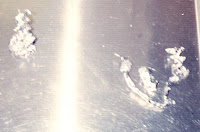Tomorrow it is once again New Year’s Eve (Uudenvuodenaatto). We are saying bye-bye to the old year and welcoming the new year. In Finland the change of the year is celebrated in quite many ways, which most are the same as around the western world. We have the fireworks. We celebrate the coming year with our friends and family by eating well, having fun together and playing or dancing.
We also have an old tradition, that dates back to the 18th century. The tradition came to Finland of course from Central Europe and Sweden and was first only done by the gentry, but as early as in 19th century it became also common among the commonalty.
We cast tin. Nowadays the metal is mostly lead and only very small portion of it is tin, but still today we cast tin. The casting is usually done during the New Year’s Eve, before the year is changed. We take a very small scoop made out of metal and place it above heat source (usually on electric stove not fire though), put a horseshoe shaped metal item on the scoop and let it melt. After it has melted, the scoop is emptied quickly in to a bucket filled with cold water. One has to be really careful when pouring the liquid metal into the water. First of all the melted metal may splatter and one may get melted metal on skin. It burns a lot and makes bad damage in just few seconds. It should be wiped away before putting cold water on it. Otherwise only the surface will cool and there will still be hot metal against the skin. Secondly it will bring bad luck, if the melted metal is not poured continuously. The metal cools instantly when in the cold water and forms different kind of shapes.
When all have casted their tins, it is time to read the new year’s fortune or events from the shapes and forms of the tins. If the tin has lot of rough surface, the caster will get money in the new year. If the tin has lots of shiny and even surfaces, the caster will have peace and good fortune. The form of the tin tells many stories; horse or ship shape means travelling, ring wedding, broken ring divorce, star good fortune. The shape of the tin can be interpreted as seen or then the tin can be held in candle or lamp light and the shadow will be interpreted. Everybody can let their imagination fly and usually we get good laughs, when interpreting the tins.
Happy New Year 2013!
Hyvää Uutta Vuotta 2013!



